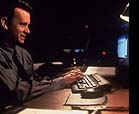1946 The Computer
2000? Mobile Phones
The Internet
The Internet recently celebrated its 30th birthday.
On October 20, 1969 a computer at the University of California transmitted data - the letters L and O - to another machine at a research centre in Stanford, near San Francisco. Hardly anyone took any notice. Now the revolution that began with barely a whisper envelops us all. Today there are tens of millions of people communicating with each other all over the world - for the cost of a local phone call. Tomorrow there will be more.
 Tom Hanks makes use of the internet in the movie 'You've got Mail'. |
The personal computer revolution led to the World Wide Web, which is growing at an exponential rate. All human life, obsessions, hobbies and, alas, perversions are available for view - often with pictures attached. Millions of different 'pages' ranging from online magazines, to travel agents and pages run by ferret fanciers in New England. It is a free-ranging anarchic research tool, one of the great wonders of the twentieth century.
The Web is already changing the way people live, communicate and shop. Its future growth depends on external factors, not internal dynamics. Connection speeds and portability.
It is already easy - if not especially healthy - to stay at home and buy everything online. Cars, houses, food, drink, books, cds, computers, the list grows by the day. Pictures, music and information (Encyclopaedia Britannica recently placed its 44 million words on the Net for free) can be downloaded for nothing. Dial up and pipe in movies will surely follow - which won't do Blockbuster much good.
The problem is speed. Being stuck with a 56k modem is the equivalent of trying to pour a gallon of water through a straw. Once home computers are linked to the Net by broadband everything will change. The three most common types of broadband - high-speed technologies that connect at speeds 50-times faster than a modem - currently are ADSL, cable modem, and satellite delivery systems. ADSL, which BT are planning to make available within the year, uses their existing cable, does not interfere with anyone using the phone but has a permanent connection to the Web. Email is sent and received instantly, click on Expedia and you can book your holiday in seconds. No faffing about. The initial problem is cost - but that will drop.
It's an old truism that individuals can get on with each other regardless of race, colour and creed, where governments cannot. It is a matter of establishing a means of understanding each other, of finding common ground, a common language. While the accepted language of the Net is English, simultaneous translation by computer is already being successfully demonstrated in laboratories. Once that becomes commercially available any written language barrier will disappear. Simultaneous voice translation may take a little longer.
The chatroom is a place where individuals can adopt a different personality. We are not too far from realising another science fiction construct. The avatar, a person's online alter ego who can look anyway you want but walk, talk and interact with other avatars. Freeserve is about to introduce "3D chat", that will take its members into virtual worlds to meet and converse. Okay so its a bit crude right now for while the landscapes inside the virtual worlds are pretty convincing, the avatars resemble Chinese terracotta warriors but with less range of expression. As a conversation is typed into a space below the picture, exchanges are stilted and artificial. But wait until the figures start to move and talk.
Some 20 years ago the humorous writer Douglas Adams dreamt up The Hitchhiker's Guide To the Galaxy. The Guide was an interactive guide book that could dispense the sum of all available knowledge wherever the hapless hero found himself. Earlier this year Adams' company, the Digital Village, launched a web site that is attempting to emulate his literary creation. The next problem is finding a computer small and fast enough to be able to access the Guide and tell you of its findings.
The technology exists. It's called a mobile phone. Imagine this scenario. You are driving to a meeting. On your wrist is an outsized digital watch with a small LCD screen. It does tell the time but it is also a phone, pager and a permanent net connection. It is voice activated. In your ear you wear a tiny earpiece. On the dashboard is a flat LCD screen, the size of a reporter's notebook. They both connect to the watchphone by Bluetooth [link to link 6]. You need somewhere to park so the phone accesses the net, finds where the nearest available space is and downloads a map of the area onto the dashboard screen. It shows your position using the on car GPS and shows you the most direct route avoiding traffic jams.
All that technology is currently available. It's just not connected up fast enough. But in the future the net will be truly portable.

